Abstract
A major assumption underlying the use of contrast sensitivity testing is that it predicts whether a patient has difficulty seeing objects encountered in everyday life. However, there has been no large-scale attempt to examine whether this putative relationship actually exists. We have examined this assumption using a clinic based sample of adults aged 20-77 years. Contrast thresholds were measured for both: (1) gratings of 0.5-22.8 cycles/degree; and (2) real-world targets (faces, road signs, objects). Multiple regression techniques indicated that the best predictors of thresholds for real-world targets were age and middle to low spatial frequencies. Models incorporating these variables accounted for 25-40% of the variance. Although acuity significantly correlated with thresholds for real-world targets, the inclusion of acuity as a predictor variable did not improve the model. These data provide direct evidence that spatial contrast sensitivity can effectively predict how well patients see targets typical of everyday life.
Full text
PDF





Selected References
These references are in PubMed. This may not be the complete list of references from this article.
- Abrahamsson M., Sjöstrand J. Impairment of contrast sensitivity function (CSF) as a measure of disability glare. Invest Ophthalmol Vis Sci. 1986 Jul;27(7):1131–1136. [PubMed] [Google Scholar]
- Arden G. B. The importance of measuring contrast sensitivity in cases of visual disturbance. Br J Ophthalmol. 1978 Apr;62(4):198–209. doi: 10.1136/bjo.62.4.198. [DOI] [PMC free article] [PubMed] [Google Scholar]
- Derefeldt G., Lennerstrand G., Lundh B. Age variations in normal human contrast sensitivity. Acta Ophthalmol (Copenh) 1979 Aug;57(4):679–690. doi: 10.1111/j.1755-3768.1979.tb00517.x. [DOI] [PubMed] [Google Scholar]
- Evans D. W., Ginsburg A. P. Contrast sensitivity predicts age-related differences in highway-sign discriminability. Hum Factors. 1985 Dec;27(6):637–642. doi: 10.1177/001872088502700602. [DOI] [PubMed] [Google Scholar]
- Fiorentini A., Maffei L., Sandini G. The role of high spatial frequencies in face perception. Perception. 1983;12(2):195–201. doi: 10.1068/p120195. [DOI] [PubMed] [Google Scholar]
- Ginsburg A. P., Evans D. W., Cannon M. W., Jr, Owsley C., Mulvanny P. Large-sample norms for contrast sensitivity. Am J Optom Physiol Opt. 1984 Feb;61(2):80–84. doi: 10.1097/00006324-198402000-00003. [DOI] [PubMed] [Google Scholar]
- Ginsburg A. P., Evans D. W., Sekule R., Harp S. A. Contrast sensitivity predicts pilots' performance in aircraft simulators. Am J Optom Physiol Opt. 1982 Jan;59(1):105–109. doi: 10.1097/00006324-198201000-00020. [DOI] [PubMed] [Google Scholar]
- Kline D. W., Schieber F., Abusamra L. C., Coyne A. C. Age, the eye, and the visual channels: contrast sensitivity and response speed. J Gerontol. 1983 Mar;38(2):211–216. doi: 10.1093/geronj/38.2.211. [DOI] [PubMed] [Google Scholar]
- Marron J. A., Bailey I. L. Visual factors and orientation-mobility performance. Am J Optom Physiol Opt. 1982 May;59(5):413–426. doi: 10.1097/00006324-198205000-00009. [DOI] [PubMed] [Google Scholar]
- Owsley C., Sekuler R., Boldt C. Aging and low-contrast vision: face perception. Invest Ophthalmol Vis Sci. 1981 Aug;21(2):362–365. [PubMed] [Google Scholar]
- Owsley C., Sekuler R., Siemsen D. Contrast sensitivity throughout adulthood. Vision Res. 1983;23(7):689–699. doi: 10.1016/0042-6989(83)90210-9. [DOI] [PubMed] [Google Scholar]
- Sekuler R., Owsley C., Berenberg R. Contrast sensitivity during provoked visual impairment in multiple sclerosis. Ophthalmic Physiol Opt. 1986;6(2):229–232. [PubMed] [Google Scholar]


